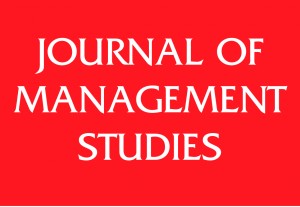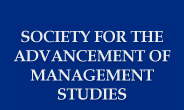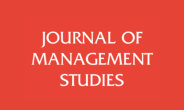
Call for Papers for a Special Issue
CORPORATE STRATEGY AND THE THEORY OF THE FIRM
IN THE DIGITAL AGE
Submission Deadline: 31 January 2019
Guest Editors:
Julian Birkinshaw, London Business School
David J. Collis, Harvard University
Nicolai Foss, Bocconi University
Robert E. Hoskisson, Rice University
Sven Kunisch, University of St. Gallen
Markus Menz, University of Geneva
JMS Editor:
John E. Prescott, University of Pittsburgh
Background
Corporate strategy is a major research area in management. Early literature emphasized such issues as diversification, mergers and acquisitions, and vertical integration (Hill and Hoskisson, 1987; Rumelt, 1982), and over the years the field has broadened to include such topics as the coordination of a firm’s business portfolio (Ahuja and Novelli, 2017; Collis and Montgomery, 1998), the demographic profiles and boundaries of industries, national markets, strategic groups, and categories (Cattani, Porac and Thomas, 2017), and corporate roles, structures, and headquarters activities (Josefy, Kuban, Ireland and Hitt, 2015; Menz, Kunisch and Collis, 2015). Rooted in the classical Coasian questions of the boundaries, and internal organization of the firm (Coase, 1937), these inquiries are fundamentally concerned with the raison d’etre of firms.
While these collective research efforts have greatly improved our understanding of the corporate strategy domain, the emergence of the ‘digital age’ presents fundamental challenges to our understanding of the dynamics of firm boundaries and organization. In particular, the digital age underscores the importance of understanding firm-level dynamics as fundamentally intertwined with changes at higher levels, whether industries, ecosystems, nations or regions (Davis, 2016). The opportunities for firms to leverage their presence in one market into other areas; the emergence of broader ecosystems that include all players in the value net; the appeal of multi-sided “platform” business models that bring together disparate players; and the growing importance of data and analytics to competitive advantage across many industries; all of these trends put new demands on firms, in terms of their choice of market positions, their vertical and horizontal scope, and the management of their boundaries.
Research that incorporates the new realities of the digital age promises to contribute to key debates in corporate strategy and advance theories of the firm. At the market level, digitalization is affecting competition by fostering the “blurring of market boundaries”, the rise of new “industries”, and the emergence of ecosystems (e.g. Atluri, Dietz and Henke, 2017). These developments challenge, for example, existing knowledge about relatedness, which largely rests on measures from the Industrial Age based on Standard Industry Classification codes (Jacquemin and Berry, 1979; Palepu, 1985). They also raise novel research questions with respect to demographic profiles and boundaries of changing industries (e.g. Agarwal, Sarkar and Echamebadi, 2002; Jacobides and Winter, 2005; Porac et al., 1995). In general, digitalization prompts us to rethink whether the traditional units of analysis are still useful and keeping up with the actual nature of competition in the 21st century.
At the firm level, the boundaries between organizations and markets are increasingly ambiguous and changing (Davis, 2016). These developments, as well as the rise of new “giant firms” that dominate entire sectors, like Google, Amazon and Tencent, urge us to challenge our existing understanding and explore new research questions. For example, digitalization’s impact on transaction and information costs may inform fundamental firm-level debates about markets versus hierarchies, vertical/horizontal firm boundaries (e.g. Afuah, 2003; Josefy et al., 2015), and the redeployment of firms’ resources to other markets (e.g. Sakhartov and Folta, 2015). The potentially changing nature of firm boundaries also provides sources of important research questions to the adjacent research on mergers and acquisitions, divestitures, and alliances (e.g. Shi, Sun and Prescott, 2012).
At the intra-firm level, digitalization’s impact on information processing, knowledge transfer and resource sharing suggests a need to revisit research findings and theories about the firm’s internal organization. New insights may inform debates about corporate roles and internal resource allocation (e.g. Arrfelt, Wiseman, McNamara and Hult, 2015; Sengul and Gimeno, 2013), corporate control (e.g. Kownatzki, Walter, Floyd and Lechner, 2013), corporate strategy formation and corporate initiatives, and corporate leadership (e.g. Whittington, Yakis-Douglas, Ahn and Cailluet, 2017). For example, big data and new analytical tools make novel ways of strategizing possible, which may influence the tension between top-down versus bottom-up planning and centralized versus decentralized decision-making.
Aims and Scope
Against this backdrop, the rise of the digital age urges us to rethink corporate strategy, to challenge traditional units of analysis and taken-for-granted assumptions, and to explore new phenomena. A concerted effort holds the potential to open up alternative units of analysis beyond what Bettis (1998) called “the usual suspects” in existing corporate strategy research, to advance novel concepts, and new relationships to ultimately enhance our theoretical and managerial understanding of corporate strategy in the 21st century.
The purpose of this Journal of Management Studies Special Issue is thus to advance our theoretical and managerial understanding of corporate strategy in the digital age. This Special Issue seeks contributions that build on or substantially extend existing research streams on corporate strategy and market boundaries. We invite submissions that offer new concepts of competition, markets, and organizations, as well as submissions that develop key theoretical concepts, such as agency, transaction costs, information and technology, knowledge management and learning, and capability and resource development/deployment.
While this Special Issue is open-minded regarding phenomena, theories, and methodological approaches, contributions should relate to corporate strategy and theories of the firm with a particular emphasis on digitalization. We encourage submissions that build upon strategy, economic, financial, and organizational perspectives, and that are conceptual, quantitative, or qualitative. Specifically, we see potential for theory development and its application to advance key corporate strategy debates on the market/competition, firm/organization, and intra-firm levels. Exemplary research questions pertaining to key debates within the intended scope of this Special Issue include, but are not limited to, the following:
The market level:
- How does digitalization affect competition, markets, industry structures, and industry boundaries?
- What explains the blurring of market boundaries, the rise of new industry sectors, and high-velocity industry change in the digital age?
- Are there new ways to conceptualize the firm’s portfolio of market units that go beyond traditional measures of diversification and relatedness?
- What role does corporate strategy play in broader ecosystems where firms coexist with partners, competitors, and complementors?
- How does digitalization change competition and corporate strategy in different contexts, for example emerging versus developed markets?
The firm level:
- How does digitalization affect transaction costs, information costs, bureaucratic costs, and the boundaries of the firm?
- What are the determinants and consequences of blurred firm boundaries (e.g., network organizations and the use of contractors in the “Gig Economy”)?
- How does the scale and scope of the firm change in the digital age? For example, does scale still matter? What explains the rise of new giant firms?
- What is the raison d’etre of a multi-business corporation? What are the new ways such firms add value to their constituent businesses?
- What are effective horizontal and vertical strategies in the digital age?
- What are the micro-mechanisms through which corporate diversification adds or subtracts value in the digital age?
- Which organization designs are suitable for the digital age?
The intra-firm level:
- How do firms develop, deploy, and renew corporate capabilities, knowledge, and resources to cope with digital transformation?
- How do corporate strategizing and the role of the corporate level differ in the digital age, or the network economy, in comparison to the industrial age?
- How does the digitalization, such as the use of big data and new analytical tools, change corporate strategy activities, including strategic planning and resource allocation processes, as well as strategy execution?
- How do firms manage corporate (digital) initiatives to transform the organization?
- What explains the changing nature of headquarters, and how they relate to internal and external? What are effective headquarters design and location choices for the digital age?
- What explains changes in corporate-level staff, including specific top management roles like chief digital officers and specialists in new central functions like corporate venturing? To what extent do such changes help firms cope with challenges in the digital age?
Submission Process and Deadlines
- The deadline for submissions is 31 January 2019.
- Submissions should be prepared using the JMS Manuscript Preparation Guidelines (http://www.socadms.org.uk/wp-content/uploads/JMSManuscript-Preparation-Guidelines.pdf).
- Manuscripts should be submitted by e-mail to Margaret Turner at jms@durham.ac.uk
- Papers will be reviewed according to the JMS double-blind review process.
- Informal enquiries relating to the Special Issue, proposed topics and potential fit with the Special Issue objectives are welcomed. Please direct any questions to the Guest Editors
Special conference and manuscript development workshop:
- The guest editors of this Special Issue are planning to hold a special conference and manuscript development workshop at Harvard Business School, Boston, MA (USA), in August 2019.
- Authors who are invited to “revise and resubmit” (R&R) a manuscript will be invited to attend this workshop. Please note that participation in the workshop does not guarantee acceptance of the paper in the Special Issue. Furthermore, attendance is also not a prerequisite for publication.
Further Information
For questions regarding the content of this Special Issue, please contact the guest editors:
- Julian Birkinshaw, London Business School: jbirkinshaw@london.edu
- David J. Collis, Harvard University: dcollis@hbs.edu
- Nicolai Foss, Bocconi University: foss@unibocconi.it
- Robert E. Hoskisson, Rice University: e.hoskisson@rice.edu
- Sven Kunisch, University of St. Gallen: kunisch@unisg.ch
- Markus Menz, University of Geneva: menz@unige.ch
References
Afuah, A. (2003). ‘Redefining Firm Boundaries in the Face of the Internet: Are Firms Really Shrinking?’. Academy of Management Review, 28, 34-53.
Agarwal, R., Sarkar, M. and Echamebadi, R. (2002). ‘The Conditioning Effect of Time on Firm Survival: An Industry Life Cycle Approach’. Academy of Management Journal, 45, 971-94.
Ahuja, G. and Novelli, E. (2017). ‘Redirecting Research Efforts on the Diversification–Performance Linkage: The Search for Synergy’. Academy of Management Annals, 11, 342-90.
Arrfelt, M., Wiseman, R. M., McNamara, G. and Hult, G. T. M. (2015). ‘Examining a Key Corporate Role: The Influence of Capital Allocation Competency on Business Unit Performance’. Strategic Management Journal, 36, 1017-34.
Atluri, V., Dietz, M. and Henke, N. (2017). ‘Competing in a World of Sectors without Borders’. McKinsey Quarterly, 54, 1-14.
Bettis, R. A. (1998). ‘Commentary on ‘Redefining Industry Structure for the Information Age’ by J. L. Sampler’. Strategic Management Journal, 19, 357-61.
Cattani, G., Porac, J. F. and Thomas, H. (2017). ‘Categories and Competition’. Strategic Management Journal, 38, 64-92.
Coase, R. H. (1937). ‘The Nature of the Firm’. Economica, 4, 386-405.
Collis, D. J. and Montgomery, C. A. (1998). ‘Creating Corporate Advantage’. Harvard Business Review, 76, 71-83.
Davis, G. F. (2016). The Vanishing American Corporation: Navigating the Hazards of a New Economy. Oakland, CA: Berrett-Koehler Publishers, Inc.
Hill, C. W. L. and Hoskisson, R. E. (1987). ‘Strategy and Structure in the Multiproduct Firm’. Academy of Management Review, 12, 331-41.
Jacobides, M. G. and Winter, S. G. (2005). ‘The Co-Evolution of Capabilities and Transaction Costs: Explaining the Institutional Structure of Production’. Strategic Management Journal, 26, 395-413.
Jacquemin, A. P. and Berry, C. H. (1979). ‘Entropy Measure of Diversification and Corporate Growth’. Journal of Industrial Economics, 27, 359-69.
Josefy, M., Kuban, S., Ireland, R. D. and Hitt, M. A. (2015). ‘All Things Great and Small: Organizational Size, Boundaries of the Firm, and a Changing Environment’. Academy of Management Annals, 9, 715-802.
Kownatzki, M., Walter, J., Floyd, S. W. and Lechner, C. (2013). ‘Corporate Control and the Speed of Strategic Business Unit Decision Making’. Academy of Management Journal, 56, 1295-324.
Menz, M., Kunisch, S. and Collis, D. J. (2015). ‘The Corporate Headquarters in the Contemporary Corporation: Advancing a Multimarket Firm Perspective’. Academy of Management Annals, 9, 633-714.
Palepu, K. (1985). ‘Diversification Strategy, Profit Performance, and the Entropy Measure of Diversification’. Strategic Management Journal, 6, 239-55.
Porac, J. F., Thomas, H., Wilson, F., Paton, D. and Kanfer, A. (1995). ‘Rivalry and the Industry Model of Scottish Knitwear Producers’. Administrative Science Quarterly, 40, 203-27.
Rumelt, R. P. (1982). ‘Diversification Strategy and Profitability’. Strategic Management Journal, 3, 359-69.
Sakhartov, A. V. and Folta, T. B. (2015). ‘Getting Beyond Relatedness as a Driver of Corporate Value’. Strategic Management Journal, 36, 1939-59.
Sengul, M. and Gimeno, J. (2013). ‘Constrained Delegation: Limiting Subsidiaries’ Decision Rights and Resources in Firms That Compete across Multiple Industries’. Administrative Science Quarterly, 58, 420-71.
Shi, W. L., Sun, J. and Prescott, J. E. (2012). ‘A Temporal Perspective of Merger and Acquisition and Strategic Alliance Initiatives: Review and Future Direction’. Journal of Management, 38, 164-209.
Whittington, R., Yakis-Douglas, B., Ahn, K. and Cailluet, L. (2017). ‘Strategic Planners in More Turbulent Times: The Changing Job Characteristics of Strategy Professionals, 1960-2003’. Long Range Planning, 50, 108-19.

